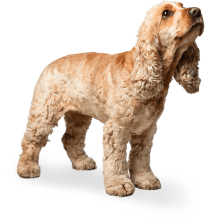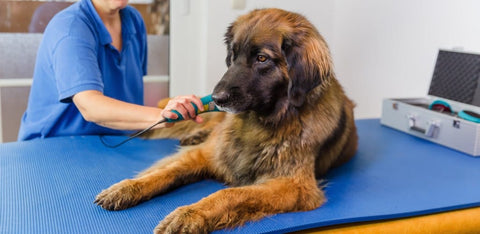

Muscle atrophy in dogs
Muscle atrophy in dogs can sound worrying but understanding what it is and how to manage it can make all the difference.
This condition happens when your dog’s muscles start to weaken or waste away. You might notice it in their back legs, but it can also affect other muscles, with the back legs and their head often being most noticeable. Whether your pup is a senior, a playful adult, or even a curious little puppy, spotting the signs early and taking a few simple steps can make a big difference in keeping that tail wagging happily. Let’s find out more.
What is muscle atrophy in dogs?
As you now know, muscle atrophy means the loss or weakening of muscle tissue in your dog. It’s crucial for you as a pet owner to be aware of it, because it can affect their mobility, comfort, and happiness. Muscle atrophy can make walking difficult for your dog and, alongside stiffness, can slow them down.
This condition doesn’t always scream for attention, though. Some early signs might be easy to miss — like your dog using their front legs more than their back ones or hesitating during walks. If you’re concerned about your dog’s behaviour or movement, spotting the signs early can lead to practical solutions.
What age and breed of dogs does muscle atrophy affect?
All dogs can experience muscle atrophy, but some breeds and age groups are more prone.
Older, less active dogs are more likely to experience it, while certain breeds are more likely to suffer from types of ‘myopathy’, which are diseases that cause damage to muscles and can lead to muscle atrophy. Diseases of the nerves (neuropathy) and spinal cord (myelopathy) can also affect muscle mass and result in muscle atrophy.
There are two main categories of breed:
1) Large dogs
German Shepherds are prone to canine degenerative myelopathy, which causes hind-limb weakness. Labrador Retrievers can be affected by centronuclear myopathy leading to muscle loss in their first year, and Great Danes can inherit a disorder that causes muscle wasting.
2) Sighthounds
Some sighthounds are also affected by muscle loss, but for completely different reasons. When a breed such as a Greyhound experiences Exertional Myopathy, it’s usually because they have over-worked their muscles through intense activity.
 Why does it occur?
Why does it occur?
Muscle atrophy can occur for several reasons. Ageing plays a big part, as dogs naturally lose muscle tone as they get older. A sedentary lifestyle can also contribute. If your dog doesn't get enough exercise, they could experience muscle loss simply because they’re not using their muscles as they should.
Conditions like joint pain or previous injuries also make it harder for dogs to stay active, which can lead to muscle atrophy over time.
Certain diseases that contribute to muscle wastage are also thought to be inherited, which is why they can be more common in some breeds than others.
Where does it occur?
Muscle wastage often occurs in the back legs, but it can affect many muscles within the body.
Some of the most noticeable areas include the muscles on the head (such as in cases of masticatory myositis), over their hip bones and the back legs.

Signs of muscle atrophy in dogs
If your dog is experiencing muscle atrophy, the first thing you’re likely to spot is that they’re not enjoying their walks as much as usual. It could be harder for them to walk normally, their legs might look stiff, and they may seem less comfortable moving around. Here are some signs to look out for:
- Lameness – Thinner hind legs or signs of discomfort when walking
- Weight loss – A noticeable drop in your dog’s weight or easier-to-spot bones
- Lack of energy – Your dog might drag their paws or seem less playful
-
Muscle tenderness – Flabby or tender areas when you stroke your dog
Your dog’s energy levels might dip too. They could feel a bit down or less like their usual happy, bouncy self. If this rings any bells, a visit to the vet can help get to the root of the problem.

Common causes of muscle atrophy in dogs
Here’s a quick rundown of some common triggers for muscle atrophy:
1) Lack of exercise
It’s the classic “use it or lose it” situation. Without regular movement, muscles weaken over time. Even gentle walks can help prevent this — see our exercising older dogs guide to keep your older pet active.
2) Pain, injury or surgery
Recovery from surgery, an injury or joint pain, such as stiff joints in dogs, can keep your dog from moving as much as they once did, leading to muscle loss.
3) Stress
Yes, even emotions can play a role. Prolonged stress may cause changes in your dog’s behaviour and, over time, activity levels decrease, impacting their muscles.
Common remedies, fixes and methods to prevent muscle atrophy in dogs
Once you’ve ruled out any serious underlying cause for your pet’s muscle loss with your vet’s help, here are some practical steps you can take to support your dog.
1) Make sure to keep exercising your dog regularly
Exercise will help build your dog’s muscle tone and mass, so get that tail wagging again by taking your dog out for a gentle stroll. If your dog has been finding it difficult to walk far, take it easy to start with and ask your vet for advice on the right amount of exercise for your dog, or any specific exercises they recommend.
2) Diet and supplements
Give your dog a great diet. Additional weight will add more strain to your dog’s muscles and make it harder for them to walk. So, make sure you feed them a wholesome, nutritious diet that will help them stay in condition. A daily multivitamin and joint supplement can also be considered.
3) Physical therapy
Consider options like canine physiotherapy or hydrotherapy for dogs to boost mobility and muscle strength. Many dogs enjoy the water and find it less stressful than other types of physical therapy.
Taking the next steps
Muscle atrophy in dogs might sound daunting, but with the right care and a little patience, you can help your dog feel stronger and happier. To recap, watch out for signs like weight loss, lameness, or a drop in energy. Add gentle exercise, a protein-packed diet, and possibly dog joint supplements to your dog’s routine to support their health.



